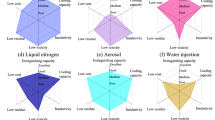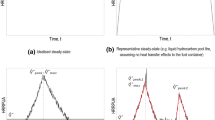Abstract
To have an insight into the fire properties of nitrocellulose–isopropanol and –ethanol mixtures, the experimental data in previous work are further extracted and analyzed carefully. Generally, the effective heats of combustion of the two samples characterized by both the peak and mean heat release rates decrease with the increasing external irradiance levels. The combustion efficiencies characterized by the ratio of carbon dioxide (CO2) to carbon monoxide (CO), regardless of the maximum and mean values, also show the similar decreasing tendency, exhibiting a lower combustion efficiency at elevated external radiation. With respect to the X-ray photoelectron spectroscopy results, the two nitrocellulose–alcohol mixtures appear to yield the similar species of combustion residuals, but slightly different in the atomic concentrations, which may be due to the differences in the alcohol humectant and nitrogen content in nitrocellulose substrate. These findings are expected to provide further understanding of fire properties of nitrocellulose–alcohol mixtures and help with fire investigation of such type of fires.










Similar content being viewed by others
References
Akhavan J. The chemistry of explosives, chapter 2. London: Royal Society of Chemistry; 2004. p. 21–48.
Tian Y, Guo K, Bian X, Wang T, Chen S, Sun J. Durable and room-temperature curable superhydrophobic composite coating on nitrocellulose lacquer. Surf Coat Technol. 2017;328:444–50.
Zhang X, Hikal WM, Zhang Y, Bhattacharia SK, Li L, Panditrao S, Wang S, Weeks BL. Direct laser initiation and improved thermal stability of nitrocellulose/graphene oxide nanocomposites. Appl Phys Lett. 2013;102(14):141905.
Zhang X, Weeks BL. Preparation of sub-micron nitrocellulose particles for improved combustion behavior. J Hazard Mater. 2014;268:224–8.
Pourmortazavi SM, Hosseini SG, Rahimi-Nasrabadi M, Hajimirsadeghi SS, Momenian H. Effect of nitrate content on thermal decomposition of nitrocellulose. J Hazard Mater. 2009;162(2–3):1141–4.
Luo Q, Ren T, Shen H, Zhang J, Liang D. The thermal properties of nitrocellulose: from thermal decomposition to thermal explosion. Combust Sci Technol. 2018;190(4):579–90.
Sun Y, Ren H, Jiao Q. Comparison of thermal behaviors and decomposition kinetics of NEPE propellant before and after storage. J Therm Anal Calorim. 2018;131(1):101–11.
Mirzajani V, Farhadi K, Pourmortazavi SM. Catalytic effect of lead oxide nano- and microparticles on thermal decomposition kinetics of energetic compositions containing TEGDN/NC/DAG. J Therm Anal Calorim. 2018;131(2):937–48.
Wei R, Huang S, Huang Q, Ouyang D, Chen Q, Yuen R, Wang J. Experimental study on the fire characteristics of typical nitrocellulose mixtures using a cone calorimeter. J Therm Anal Calorim. 2018. https://doi.org/10.1007/s10973-018-7410-9.
Katoh K, Higashi E, Nakano K, Ito S, Wada Y, Kasamatsu J, Miya H, Yamamoto M, Wada Y. Thermal behavior of nitrocellulose with inorganic salts and their mechanistic action. Propellants Explos Pyrotech. 2010;35(5):461–7.
Mahajan R, Makashir P, Agrawal J. Combustion behaviour of nitrocellulose and its complexes with copper oxide. Hot stage microscopic studie. J Therm Anal Calorim. 2001;65(3):935–42.
Makashir PS, Mahajan RR, Agrawal JP. Studies on kinetics and mechanism of initial thermal decomposition of nitrocellulose. J Therm Anal Calorim. 1995;45(3):501–9.
Wei R, He Y, Zhang Z, He J, Yuen R, Wang J. Effect of different humectants on the thermal stability and fire hazard of nitrocellulose. J Therm Anal Calorim. 2018. https://doi.org/10.1007/s10973-018-7235-6.
He Y , He Y, Liu J, Li P, Chen M, Wei R, Wang J. Experimental study on the thermal decomposition and combustion characteristics of nitrocellulose with different alcohol humectants. J Hazard Mater. 2017;340:202–12.
Wei R, He Y, Liu J, He Y, Mi W, Yuen R, Wang J. Experimental study on the fire properties of nitrocellulose with different structures. Materials. 2017;10(3):316.
Enright PA, Fleischmann CM. Uncertainty of heat release rate calculation of the ISO5660-1 cone calorimeter standard test method. Fire Technol. 1999;35(2):153–69.
Bench Zhao L. Bench scale apparatus measurement uncertainty and uncertainty effects on measurement of fire characteristics of material systems. Worcester: Worcester Polytechnic Institute; 2005.
Li R, Xu H, Hu H, Yang G, Wang J, Shen J. Microstructured Al/Fe2O3/nitrocellulose energetic fibers realized by electrospinning. J Energ Mater. 2014;32(1):50–9.
Hakkarainen T, Korhonen T, Vaari J. Heat release characteristics of ethanol–water mixtures: small-scale experiments. Fire Saf J. 2017;91:174–81.
Jessup RS, Prosen E. Heats of combustion and formation of cellulose and nitrocellulose (cellulose nitrate). J Res Natl Bur Stand. 1950;44:387–93.
Drysdale D. An introduction to fire dynamics. New York: Wiley; 2011.
Shao Z, Wang W. Structure and properties of cellulose nitrate. Beijing: National Defense Industry Press; 2011.
Chen M, Zhou D, Chen X, Zhang W, Liu J, Yuen R, Wang J. Investigation on the thermal hazards of 18650 lithium ion batteries by fire calorimeter. J Therm Anal Calorim. 2015;122(2):755–63.
Yang D, Velamakanni A, Bozoklu G, Park S, Stoller M, Piner RD, Stankovich S, Jung I, Field DA, Ventrice CA Jr, Ruoff RS. Chemical analysis of graphene oxide films after heat and chemical treatments by X-ray photoelectron and micro-Raman spectroscopy. Carbon. 2009;47(1):145–52.
Girard-Lauriault PL, Gross T, Lippitz A, Unger WE. Chemical and elemental depth profiling of very thin organic layers by constant kinetic energy XPS: a new synchrotron XPS analysis strategy. Anal Chem. 2012;84(14):5984–91.
Wang Y, Shao Y, Matson DW, Li J, Lin Y. Nitrogen-doped graphene and its application in electrochemical biosensing. ACS Nano. 2010;4(4):1790–8.
Malitesta C, Losito I, Sabbatini L, Zambonin PG. New findings on polypyrrole chemical structure by XPS coupled to chemical derivatization labelling. J Electron Spectrosc. 1995;76:629–34.
Niwa Y, Kobayashi H, Tsuchiya T. X-ray photoelectron spectroscopy of tetraphenylporphin and phthalocyanine. J Chem Phys. 1974;60(3):799–807.
Girard-Lauriault PL, Desjardins P, Unger WE, Lippitz A, Wertheimer MR. Chemical characterisation of nitrogen-rich plasma-polymer films deposited in dielectric barrier discharges at atmospheric pressure. Plasma Process Polym. 2008;5(7):631–44.
Sarra-Bournet C, Gherardi N, Glénat H, Laroche G, Massines F. Effect of C2H4/N2 ratio in an atmospheric pressure dielectric barrier discharge on the plasma deposition of hydrogenated amorphous carbon-nitride films (a-C:N:H). Plasma Chem Plasma Process. 2010;30(2):213–39.
Brisson PY, Darmstadt H, Fafard M, Adnot A, Servant G, Soucy G. X-ray photoelectron spectroscopy study of sodium reactions in carbon cathode blocks of aluminium oxide reduction cells. Carbon. 2006;44(8):1438–47.
Tsami A, Grillo F, Bowker M, Nix RM. Model NSR catalysts: fabrication and reactivity of barium oxide layers on Cu (1 1 1). Surf Sci. 2006;600(17):3403–18.
Ozensoy E, Peden CH, Szanyi J. NO2 adsorption on ultrathin θ-Al2O3 films: formation of nitrite and nitrate species. J Phys Chem B. 2005;109(33):15977–84.
Desikusumastuti A, Happel M, Dumbuya K, Staudt T, Laurin M, Gottfried JM, Steinrück H, Libuda J. Modeling NOx storage materials: on the formation of surface nitrites and nitrates and their identification by vibrational spectroscopy. J Phys Chem C. 2008;112(16):6477–86.
Saunders C, Taylor L. A review of the synthesis, chemistry and analysis of nitrocellulose. J Energ Mater. 1990;8(3):149–203.
Katoh K, Je L, Itoh M, Arai M, Tamura M. Study on the spontaneous ignition of cellulose nitrate effect of the type of storage atmosphere (I). Sci Technol Energ Mater. 2003;64(6):236–40.
Katoh K, Le L, Arai M, Tamura M. Study on the spontaneous ignition of cellulose nitrate effect of the type of storage atmosphere (II). Sci Technol Energ Mater. 2004;65:77–81.
Acknowledgements
This research was financially supported by Shanghai Sailing Program (Grant No. 18YF1409600), Natural Science Foundation of Shanghai (Grant No. 16ZR1414600), the National Natural Science Foundation of China (Nos. 51376172, 50909058 and 51408181), the Research Grant Council of the Hong Kong Special Administrative Region, China (No. CityU 11301015) and the Open Foundation of State Key Laboratory of Fire Science (No. HZ2016-KF13).
Author information
Authors and Affiliations
Corresponding authors
Rights and permissions
About this article
Cite this article
Liu, J., He, Y., Wang, J. et al. Investigation on the combustion efficiency and residual of nitrocellulose–alcohol humectant mixtures. J Therm Anal Calorim 136, 1807–1816 (2019). https://doi.org/10.1007/s10973-018-7817-3
Received:
Accepted:
Published:
Issue Date:
DOI: https://doi.org/10.1007/s10973-018-7817-3




